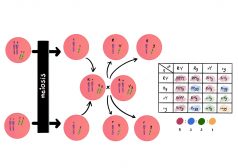Definition
noun, plural: globosides
A glycosphingolipid that has more than one sugar (usually a combination of N-acetylgalactosamine, D-glucose, or D-galactose) as the side chain of ceramide
Supplement
A glycosphingolipid is a glycolipid comprised of a carbohydrate and a sphingolipid — particularly one that has a sphingosine backbone. The carbohydrate is linked to a sphingolipid by a glycosidic bond. Examples of glycosphingolipids include cerebrosides, gangliosides, globosides, and glycophosphosphingolipids.
A globoside is a glycospingolipid in which the R group of the ceramide is comprised of more than one sugar, usually a combination of N-acetylgalactosamine, D-glucose or D-galactose. Compared with another glycosphingolipid, the cerebroside has only one sugar as the side chain of the ceramide.
Excess of globosides may lead to pathological conditions. For instance, the lack of adequate enzymes that are supposed to degrade globosides could lead to Fabry disease. The disease is a lysosomal storage disease caused by a deficiency deficiency in α-galactosidase A in the lysosomes of the endothelial cells in blood vessel walls. This results in the failure of the degradation, and thus, the accumulation, of glycolipids, particularly globotriaosylceramide. Globotriaosylceramide (also called ceramide trihexoside or Gb3) is a globoside formed by the α-linkage of galactose to lactosylceramide.
See also:
- glycosphingolipid
- glycolipid
- neuron
- cerebroside
- Fabry disease







